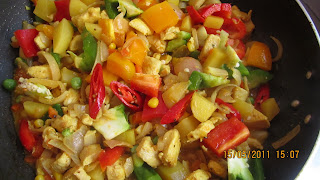 This is an absolutely gorgeous dish, that I must share with you. I wanted to try cooking a couscous dish which is not really common for us. And it turned out marvellous! My kids enjoyed making and eating it so much - they asked for more. Here's the recipe - and as always, be flexible if you need to be.
This is an absolutely gorgeous dish, that I must share with you. I wanted to try cooking a couscous dish which is not really common for us. And it turned out marvellous! My kids enjoyed making and eating it so much - they asked for more. Here's the recipe - and as always, be flexible if you need to be. This is my own recipe. I hope you like it.
 |
| CousCous |
What you will need:
 |
| CousCous soaked in water |
For 2 adults and 2 kids
CousCous  - 200 grams
- 200 grams
A little salt
A little butter
Prepare the CousCous first.
Typically, a lot of couscous comes pre-steamed .
. 
 My box said to only add the couscous in a pot of hot water.
My box said to only add the couscous in a pot of hot water.

But, I, thought, differently. I soaked it in water for about 5 minutes and steamed it for about 10 or 15 minutes. Add in the salt. Add butter when about to serve. The butter melts into the couscous.
The Chicken Dish
It's really up to your own imagination
But here's mine for the trying:
Chicken meat diced
3 onions sliced
3 cloves of garlic sliced
mixed vegetables - carrot, corn and green peas which you can get in the supermarket
capsicum - green, yellow and red
1 potatoes diced
 |
| Vegetables, Capsicum |
sliced chili
you can add other vegetables as well like aubergines and zucchini
1 tablespoon of paprika or chili powder
1 tablespoon of turmeric powder
1 teaspoon of black pepper
salt to taste
 |
| Saute onion |
Saute the onions and garlic
Add the chicken and potatoes
Add the paprika and turmeric powder
Add in the vegetables
And salt to taste.
 |
| Add flavour |
 |
| All ingredients cooking |
And you are done.
 |
| Mixed vegetables |
Teaching Notes
Explain to the children about cous cous and the countries it comes from.
Show them the atlas.
Couscous is a North African (like Morocco) dish of semolina traditionally served as with a meat or vegetable stew spooned over it.
Couscous is a staple food throughout West Africa, Sahel, France, Spain, and the Canary Islands, Portugal, Madeira, Italy (particularly in western Sicily's Province of Trapani), id as well as in Turkey, Greece, Malta, Cyprus, the Middle East and India.
For parents,
Did you know that Couscous is among the healthiest grain-based products. It has a glycemic load per gram 25% below that of pasta. It has a superior vitamin profile to pasta, containing twice as much riboflavin, niacin, vitamin B6, and foliate, and containing four times as much thiamine and pantothenic acid. In terms of protein, couscous has 3.6 g for every 100 calories, equivalent to pasta, and well above the 2.6 g for every 100 calories of white rice. Couscous contains a 1% fat-to-calorie ratio, compared to 3% for white rice and 5% for pasta
 |
| Completed Dish - Ready to Serve |
Happy Teaching and Cooking!











